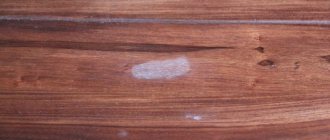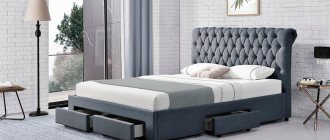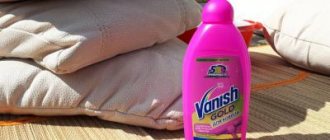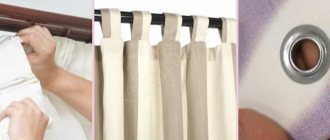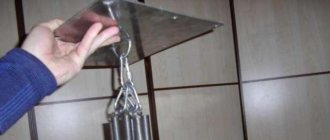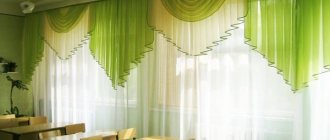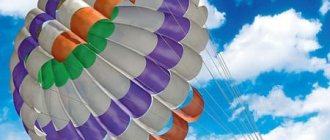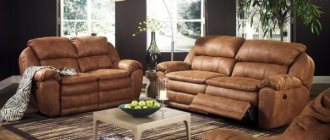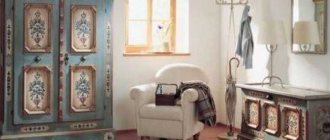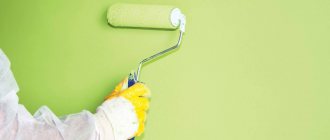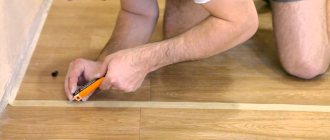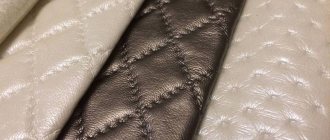In furniture production, flock is widely used as an upholstery fabric. It became popular due to its quality characteristics, inexpensive production, and low price. Interesting note! Initially, waste from the production of wool, cotton and synthetic threads was used to make flock.
The name of the fabric “flock” comes from the English “floc” - “fluff”, “shred”. The fabric with this name is a non-woven textile, which consists of a base and a pile glued to it on one side.
Description of production technology
A thin layer of glue is applied to the woven base, which moves along the machine. And from the hopper located above the machine, flock (lint particles) is evenly poured onto it. They are electrified and fall strictly vertically onto the adhesive base: this is how an even coating is achieved.
Whether the fabric will be soft or hard depends on the length of the fibers and the density of the pile filling (the denser the filling, the softer the surface to the touch and the better the wear resistance of the material.).
High-quality flock has straight fibers, equal in length, and their tips are not fused together. This is achieved through processing and activation of the pile: it is given electrical conductivity using certain reagents. Such fibers “correctly” lie on a grounded textile base. The main indicator of flock quality is how tightly the pile is glued to the base.
The pile can be:
- ground , i.e. the fibers are ground in special devices. The fibers are of different lengths; after application to the base, the resulting material looks like suede. Ground flock is used to make velvet paper and packaging;
- cut - the threads are folded into bundles (bundles) and cut evenly, i.e., the fibers are the same size.
In what cases can long sleeping pillows come in handy?
A set of towels in gift wrapping is a great gift for any occasion.
Which eurocover is suitable for a corner sofa? Reviews at the link //izvolokna.com/domashnii/gostinnaya/nakidki-na-mebel/evrochexol-dlya-divana.html.
Flock is painted in two ways:
- Coloring of raw polyamide before production of the rope;
- Coloring the fibers after cutting the threads.
When dyeing raw materials, manufacturers set themselves the goal of obtaining a material with the following characteristics:
- color fastness (shades should not change or fade when exposed to moisture);
- resistance to burnout;
- resistance to detergents.
The fabric is dyed in different colors.
Features of fabric production
As already mentioned above, flock production occurs in several stages. The process uses two parts: the base, which is a dense load-bearing fabric, and the pile itself. More details about the stages:
- Pile cutting. This step is needed to create a soft top layer. Lint is obtained in one of two ways:
- raw materials are ground into fractions;
- The thread is wound into thick jutes and finely chopped.
The result in both cases is the same - a homogeneous fiber that is pleasant to the touch.
- Coloring. Most often it occurs in the second stage, but sometimes the situation can change and coloring occurs before the cutting process. In general, flock dyes very well and evenly (with the exception of some artificial types). Firstly, dyes make it possible to diversify the palette of colors, and secondly, they improve the properties of the fabric, namely, they improve moisture resistance, protect the fabric from ultraviolet radiation and chemical compounds.
- Fabric processing. This is the very last stage at which two components—the base and the pile—are combined into the finished product. This happens in several stages:
- electrification of the pile by charging it with special equipment, thanks to which the pile is laid evenly vertically on the base;
- spraying - the base is covered with the thinnest layer of glue and the prepared pile is placed on it;
- fastening - after joining two layers, the canvas is coated with a special compound, which makes it more uniform, beautiful and with improved characteristics.
Upholstery
Material characteristics: wear-resistant, durable
Phlox is widely used in the production of upholstered furniture due to its properties:
- Wear resistance . The fabric is very resistant to abrasion (Russian GOST requires 6000 cycles, and flock can withstand up to several tens of thousands of cycles!) It is resistant to temperature changes, does not fade in the sun, does not fade, and does not deform.
- Durability (hard to break).
- Water resistance . Flock does not get wet. The water rolls around like mercury balls, you can quickly get wet with a napkin.
- Easy to care for.
- It feels pleasant, soft, warm.
Attention! Cheap flock does not always have these advantages.
What bedspreads are suitable for a 240x260 bed?
Casanova bed linen is distinguished by its sophistication and quality. Here's a photo.
Sizes of 1.5 bedding sets may vary depending on the manufacturer: //izvolokna.com/domashnii/spalnya/postelnoe-bele-s/razmery-1-5.html.
Disadvantages of flock fabric
- It is highly electrified, which attracts dust.
- When exposed to alcohol-containing substances, the structure of the material is disrupted.
A new generation of flock – flock on flock. It differs from the usual one in its manufacturing technology: a second layer of lint is applied to the first layer of lint. As a result, the fabric is more textured and voluminous. Colors and shades can also be unusual and iridescent.
In addition to furniture production, flock is used for car upholstery; toys, packaging, and decorative items are made from it.
How is it different from other similar fabrics?
Flock is far from the only fabric used for furniture upholstery. Along with it, fabrics such as chenille and matting are widely used. However, there are still differences between these materials:
- chenille does not have pile, which tends to wrinkle and wear off, making the fabric more durable;
Chenille upholstery
- matting is the strongest fabric, tactilely loose and not as pleasant as flock, but at the same time it can serve for a very long time;
You might be interested in Description of nylon, areas of application of the fabric and types of fibers
Matting upholstery
- flock is the most beautiful and soft, moreover, most of its types have an excellent ability to repel moisture, which other fabrics cannot boast of (chenille and matting absorb it instantly).
The choice of fabric directly depends on the purpose of use and the desired qualities.
Care instructions
- Dry cleaning is prohibited!
- Wash on delicate cycle and with liquid soap, not powder! Flock should be ironed according to the instructions on the label. If there are none, you can iron them in the “synthetic” mode from the wrong side.
- Remove stains immediately while they are fresh. A dried stain cannot be scraped off. First, you should soak it with water, going over the dirt with a damp soft sponge.
- You can wash off the stain with a soap solution, moving from the edges to the middle. Leave the soapy area for a couple of minutes and then rinse with clean water using a sponge. Wipe with a dry towel or napkin. Comb the dried pile with a soft brush.
- Furniture upholstered with flock must be vacuumed periodically to remove dust.
It is forbidden to clean flock with alcohol, gasoline, or solvents (the glue that holds the pile in place may dissolve). Only water-based products can be used!
Prices for material fluctuate over a wide range and depend on many indicators: manufacturer, fabric composition, wholesale purchase or retail. Each time you need to check the price with the seller.
Fabric from Switzerland, America, Belgium, and Turkey has proven itself well. But with Chinese material you need to be careful when choosing, a very cheap one can let you down in quality. Today, the average price for flock made in China is 650 rubles, made in Belgium - 1000 rubles, USA - 1600 rubles.
When choosing flock upholstery fabric for sofas, you can be sure of the right choice: the furniture will last a long time, delighting you with an attractive appearance and easy care. Also read about the types of fabrics for sofa upholstery in this article.
You can get acquainted with the assortment of furniture fabrics at the Mebelieri store here.
Advantages and disadvantages
Practical and durable material stands out for its interesting texture, which distinguishes the fabric from other types of furniture materials.
Pros:
- spectacular appearance;
- softness of the canvas and pleasant tactile sensations;
- durability;
- wear resistance;
- ease of care;
- sufficient resistance to moisture;
- variety of color palette.
Minuses:
- accumulation of static electricity;
- unstable to some chemicals, for example, alcohol-containing ones.
Unlike many fleecy materials, this canvas can not only be painted in different colors, but also have an original relief print. Most often, flock has a geometric, laconic pattern that will look good on furniture or in a car showroom.
Reviews
Elena:
10 years ago we ordered a sofa. We chose flock upholstery, made in Canada, we are very pleased, during this time the material has remained virtually unchanged. We vacuum about once a month and that’s it. The pile is practically not wrinkled, there are no bald spots.
Marina:
In our kitchen we have a corner sofa with flock upholstery. I really like it: I washed the stains with a soap solution (diluted with dishwashing detergent) and a sponge. The child spilled the compote, they wiped it off so quickly with a towel, it didn’t even have time to soak in!
Sergey:
We bought upholstered furniture. Our little child drew on the chair with felt-tip pens, my wife immediately wiped it off with baby wipes and there was no trace left!
Elena:
We chose furniture so that the cat could not scratch. The consultant recommended flock. Well, it’s been holding on for six months already, the cat can’t get her claws in and has lost interest, until we’re disappointed.
Where is flock used?
Fleecy fabric has found application in the light, automotive and furniture industries. It is used in the following capacity:
- as furniture upholstery for living room sets;
- as textile decoration of windows, curtains, drapes;
- upholstery of passenger cars and car seats;
- material for sewing toys and small decorative items in the interior of the room;
- for gift wrapping;
- tailoring - dresses, sundresses, skirts, decoration details and shoe patches.
Criteria, standards and requirements when choosing the type of finish for a sofa
When you need to buy a new sofa or change the upholstery of an old one, consider the criteria for choosing the finishing material:
- Environmental friendliness and compliance with standards. The fewer chemical dyes used in textile production, the better. For a sofa, it is better to choose fabric that has European certificates of quality and safety. This is especially true when choosing furniture for children, teenagers and the elderly.
- Textile composition - it can be synthetic, natural or combined. At the same time, natural materials are not always the best option, especially if the sofa will be actively used. It is most advisable to pay attention to fabric that combines the advantages of natural and artificial components.
- Design and style (pattern, color, presence of prints) - it should go well with the shade and pattern of the wallpaper, type of flooring, and other furniture in the room.
- Comfort – the surface of the sofa should be pleasant to the touch.
- Wear resistance, which allows textiles not to sag under heavy weight, is expressed in tensile strength and tensile strength.
- Density – options with a density of 200 g/m2 or more are suitable for the sofa. The denser the better, as wear resistance increases, which means the cost ultimately decreases.
- Abrasion resistance - this indicator is checked using a special test by the manufacturer. Consult with an employee of the company where you are going to buy a sofa or reupholster it. Ask what the indicator is for a particular fabric - textiles must withstand at least 20 thousand friction cycles before the first signs of damage to integrity appear.
- Resistance to ultraviolet rays and fading - this should be indicated in the furniture passport. The optimal color fastness index is 3.5.
- Resistant to high temperatures and fire. This is an important factor, especially if the furniture will be in the kitchen, near the fireplace, or in the children's room. The safest textiles in this regard are labeled as the first of five classes.
- Air permeability is important when the furniture is subject to heavy loads. If the fabric does not allow air to pass through well, it may simply “come apart at the seams.”
- Impregnation, which increases the moisture-resistant and dirt-repellent properties of the upholstery, is a factor that ensures the furniture has minimal maintenance requirements. The most reliable preparations for impregnation are Teflon and Scotchgard. If textiles are processed with them, this will be indicated in the product passport, other technical document and on the label.
- Can be cleaned with a variety of household chemicals. This issue must be clarified with a store consultant, since not every fabric can be exposed to chemicals.
If the fabric meets the listed characteristics, then it is of high quality, safe and manufactured in accordance with GOST standards.
Raw materials and types of flock
The basis for the material is:
- natural,
- synthetic,
- mixed
The latter option is the most practical and durable, since the fabric contains both synthetic threads (nylon or polyester) and natural ones (cotton).
flock fibers
Flock fibers are made from various threads and fibers.
- Polyamide fibers are characterized by high wear resistance, softness, and ease of dyeing. They quickly recover after creasing.
- Polyester fibers have the same properties as polyamide fibers. However, this flock is more light-resistant and hydrophobic (repels moisture better). Among the shortcomings, it is noted that it does not paint well.
- Viscose flock is easy to dye, looks great, is pleasant to the touch, wear-resistant and durable. However, viscose fibers, even under slight loads, are easily wrinkled and deformed, but are poorly restored.
- Cotton flock is environmentally friendly and natural, but it is fragile and wears out quickly.
- Polypropylene and acetate flock is less wear-resistant and wrinkles easily. This type is the most inexpensive.
- Mixed flock, which contains natural cotton or wool threads (35%) and synthetic fibers (65%).
Advantages and disadvantages of fabric
Like other upholstery fabrics, flock has advantages and certain disadvantages that should be taken into account when choosing and caring for furniture made from this material.
Advantages of flock:
- practicality,
- strength,
- wear resistance,
- water resistance,
- breathability,
- softness and smoothness,
- easy care.
Disadvantages of fabric:
- Flock cannot be dry cleaned as it may damage the adhesive base of the fabric. Do not use any alcohol-containing products, solvents, strong reagents, petroleum products, or oils.
- Flock does not tolerate hot water well. When using large amounts of hot water during cleaning, the structure is disrupted and the elasticity of the material decreases.
- Flock accumulates static electricity and easily attracts dust.
- Acetate and viscose types of flock wrinkle easily.
If you take into account the characteristics of the material and properly care for it, then all products will retain their original appearance for a long time.
Advantages of flock sofa upholstery
Any potential buyer will be interested in what the advantage of this textile is and why he should make a choice in its favor. Positive qualities include the following characteristics:
- In appearance it resembles velvet . Furniture trimmed with such fabric looks expensive and luxurious, which will become a real decoration of the room. At the same time, it is very pleasant to the tactile sensations.
- In furniture stores now it is not difficult to choose a flock sofa . At the same time, prices can be very different, which will allow you to purchase goods for any budget.
- Due to the high density, strength increases . This textile is resistant to mechanical stress and is quite difficult to tear. This is one of the main criteria for choosing sofa upholstery.
- Pet lovers will be pleasantly surprised, since the material is resistant to scratches from claws . This is due to the fact that the material is non-woven, so the pet will not be able to pull the inside out with its claw. Therefore, you don’t have to worry that the furniture will suffer from this.
- An important advantage is moisture resistance . If liquid is spilled on it, the fabric begins to repel moisture, which cannot be said about many other types of matter.
- This upholstery is not exposed to sunlight . Flock sofas do not fade, so they can be installed in open gazebos and verandas without fear of fading.
- Wear resistance is also at a fairly high level , ahead of even more expensive types of fabrics. The fabric practically does not wear out, does not stretch, does not deform, and is resistant to pilling.
- Due to the fact that this textile is easily dyed, you can choose furniture in any color scheme that matches the interior. In addition, manufacturing methods make it possible to achieve various three-dimensional patterns, which allows you to experiment with your choice.
What kind of material
Let's figure out what kind of material this is. According to the description, the material is similar to velor. However, flock is not exactly a fabric, but a non-woven material. Flocking is a technique for applying textile waste to a base fabric. The result is a voluminous and fleecy material, which is considered an ideal fabric for furniture and carpets.
The flocking method itself was developed in China, but the name of the material is European. Translated from English, “flock” is a “piece” or “bundle,” which explains the nature of the appearance of the material. It was from cotton or wool that the material was originally made. Modern varieties are made from mixed fiber or synthetics.
The material became popular as an anti-vandal fabric - furniture upholstery that can resist cat claws. Flocked matting is in demand in the furniture business. It is affordable and looks aesthetically pleasing.
Which fabric is better - flock or velor when it comes to upholstery material? The first type is cheaper, the second is more reliable. It is believed that flock is a material that can delaminate over time if the textile fibers separate from the surface of the base. But modern flocking methods eliminate this risk. However, you should focus on the composition of the material in order to extend its service life. Thus, alcohol-containing compounds are dangerous for synthetic fabrics and lead to their damage.
When it comes to design, flocked material is superior to wool blend velor. This is a fabric that can have any color, additional embossing, selective flocking and different volumes of pile. For upholstery of furniture and in interior design, such fabric is indispensable.
